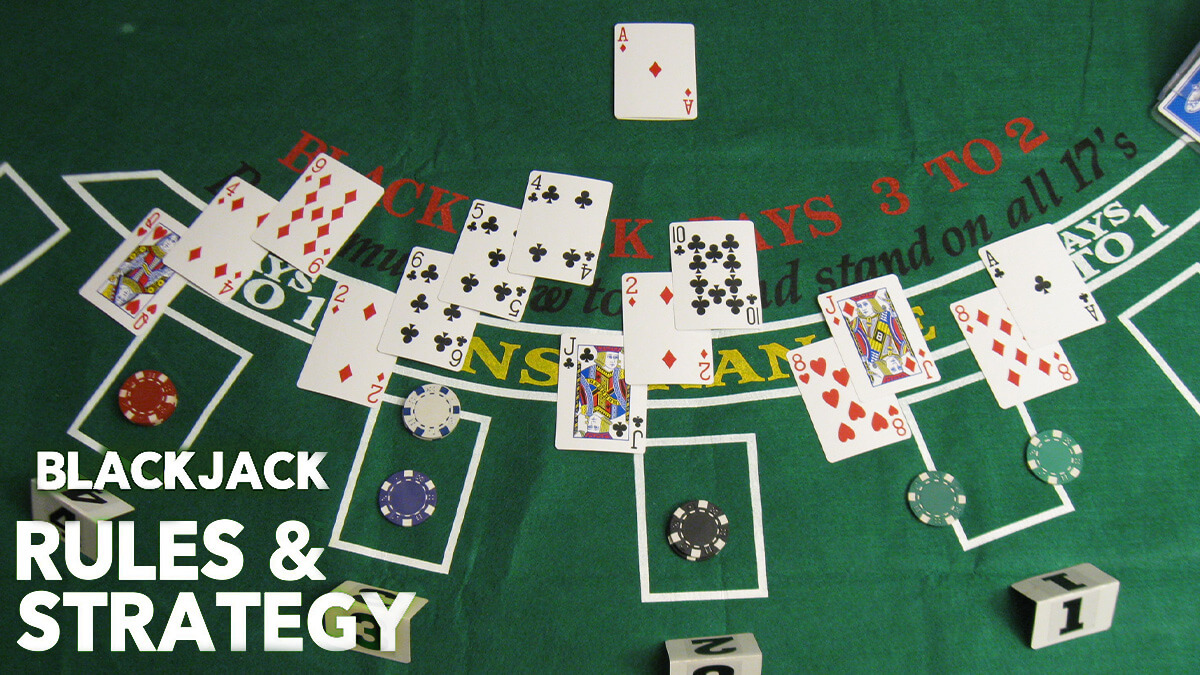It’s easy enough to find how to play blackjack articles on the internet, but a lot of them ignore the subtler aspects of the blackjack card game’s rules.
This post is my attempt to correct that and focus more on the rules of play than the basic stuff.
At the same time, this post should be more useful for the blackjack beginner because it covers rules that other pages don’t cover.
A Broad Overview of Blackjack Card Game Rules
You play real money blackjack with the same standard 52-card deck that’s used for poker or other casino card games like baccarat. The joker is never used, and there are no wild cards in blackjack. Most casinos use multiple decks of cards, usually 2, 6, or 8 decks.
The dealer uses a blank card to signify when it’s time to reshuffle the decks, and if the casino is using more than 4 decks, the cards are dealt from a box called a “shoe.” In single deck or 2-deck games, the cards are dealt by hand.
The object of the game is to get a score as close as you can to 21 without going over. You have one opponent – the dealer. How the play of the other gamblers goes has nothing to do with your own outcomes.
The cards have point values based on their rankings. In other words, the 2 of spades is worth 2 points, the 3 of hearts is worth 3 points, and so on. The suit doesn’t affect the point scores for the cards.
Face cards – the jack, queen, and king – are each worth 10 points.
And an ace counts as 1 or as 11, depending on which is better for the player.
Blackjack Betting Rules (Cash and Chips) – How to Bet on the Card Game
Before you can play, you must buy into the game. This usually means exchanging cash for chips at the blackjack table, but in many casinos, you can play cash, too. Usually you only play cash once when you first sit down at the table, though – as soon as that first hand is dealt, the dealer will want to convert your cash to chips.
It’s important that you don’t hand your cash directly to the dealer. Lay it on the table. The dealer doesn’t want to be accused of stealing your money, which is why they have such specific procedures in terms of counting your money on the table in such a way that it can be filmed by the camera above – the “eye in the sky.”
You’ll find a placard at the blackjack table which lists the betting limits. You’ll rarely find a casino offering a minimum bet of less than $5 per hand, and $500 per hand is often the maximum bet. High roller rooms often have higher betting maximums, but it’s important to know the minimum before sitting down.
You don’t want to buy in for $300 at a $100 minimum blackjack table and wind up with only 3 chips to play with.
The Rules for Dealing Blackjack – How to Deal the Card Game
The cards get shuffled periodically at most casinos, usually when the deck has been dealt down to the cut card. In some casinos, though, a continuous shuffling machine is used. In this case, you can forget all about counting cards.
The Dealer Has Specific Rules for How to Deal
She waits until everyone has placed their bets and the decks have been shuffled. Then she gives each player a card, one at a time, clockwise around the table. She also gives herself a card, face-up.
The players’ cards are dealt face-up in a game dealt from a shoe, but if the game is being dealt from the dealer’s hand, the cards are dealt face-down.
After everyone gets their first card, the dealer gives each player a 2nd card. The players either get both cards face-up or face-down, depending on the nature of the game. But the dealer’s 2nd card is always face-down.
That’s how the initial deal goes.
After that, it’s time to make game-play decisions.
Blackjack Rules for Naturals
The first thing that happens after the deal in this card game is the adjudication of “naturals”, AKA “blackjacks.”
A blackjack, or natural, is a 2-card hand worth 21 points. To get a blackjack, you must have an ace, but you must also have a 10-point card. It doesn’t matter if it’s a face card or a 10, it still counts as a blackjack if it’s 2 cards that make up a total of 21.
If a player gets a natural and the dealer doesn’t, the player immediately gets paid off at 3 to 2 odds. In other words, if you bet $5 on the hand, you win $7.50 immediately. That’s it for the hand.
Note:
Some versions of blackjack only pay off at 6 to 5 odds. You should avoid such games, as they give the house a much higher mathematical edge than the standard version of the card game.
If a dealer gets a natural and the player doesn’t, the player immediately loses. But you only lose the bet. You don’t pay a penalty or anything like that.
If both the player and the dealer get a natural, the result is a push. The player gets to keep his bet, but he doesn’t get any winnings. A push is basically the same thing as a tie.
A natural only happens about once out of every 20 of your hands, so it’s common enough that you’ll see it often.
But most of the time, you’ll still have to play your hand.
Blackjack Gameplay Rules – How to Play the Card Game
So far there hasn’t been much gameplay to discuss – just betting, shuffling, dealing, and checking for naturals.
Once all that’s done, the gameplay begins, and that’s where the rules for this card game get interesting.
The player to the dealer’s left acts first, and play proceeds around the table. The dealer acts last.
The 2 basic moves in the game are to stand or to hit. To stand means to decline any additional cards and take the total you have to the showdown. To hit means to accept another card from the dealer to increase your total score.
You have no limit to the number of additional cards you can take, but you can also decide to stand at any time.
But, if at any time, you hit and get an additional card that makes your total 22 or higher, you immediately lose and the dealer collects your bet.
This is, in fact, where the house gets its edge. Even if the dealer also busts, you’re already out of the game if you’ve busted. What should be a tie in a “fair” game is a loss for the player.
But, if you play with basic blackjack strategy, the house edge for blackjack is one of the lowest in the casino. It’s less than 1% depending on the conditions of the game.
Also, this is a good time to point out the importance of an ace. Since it can count as 1 or 11, you have more flexibility in how aggressively you play your hand. That’s why your total number of points when you have an ace in your hand is called a “soft” total. It’s impossible to bust a soft total because you can always decide to count the ace as 1 instead of 11.
The Card Game Rules for Other Player Options
Hitting and standing aren’t your only options. You can also do the following with your hand:
- Double Down – This means to double the size of your bet and take one – and only one – additional card.
- Take Insurance – This option is only available when the dealer has an ace. Insurance is a side bet that the dealer has a 10 for her face-down card, giving her a blackjack. The size of the insurance bet is half that of your initial bet, and it pays off at 2 to 1. Of course, if you win the insurance bet, you lose your main bet, breaking even for the hand. That’s why it’s called “insurance.” You’re insuring your hand against the possibility that the dealer has a blackjack.
- Split – When you have 2 cards of the same rank, like aces or 8s, for example, you can put up an extra bet and play 2 hands. The starting card for each of the 2 hands comes from your hand, and you get a new card on top of each of them. You play each hand independently from that point forward.
Rules for How the Dealer Plays Her Hand
Once all the players have busted (gotten a total of 22+) or stood, the dealer plays her hand. The dealer doesn’t get to exercise judgment when playing her hand; she must play according to the house rules for the dealer.
This means the dealer must hit any total of 16 or lower. It also means the dealer must stand on a total of 17.
There’s one wrinkle, though – a soft total of 17 might force the dealer to stand, or it might force the dealer to hit. If the dealer must stand on a soft 17, that’s an advantage for the player. If the dealer hits a soft 17, the casino has a higher edge than in the other version of the game.
Once the dealer stands, the bets are paid off. If the dealer has a higher total than the player, the dealer wins the player’s bet. If the player has a higher total than the dealer, the dealer pays the bet off at even money.
If the dealer and the player stand on the same total, the bet is considered a push. The player gets his bet back, but he gets no winnings on top of it.
Conclusion
That’s my best, most complete, and simplest explanation for blackjack card game rules.
If I left anything out, let me know in the comments.
Michael Stevens
Michael Stevens has been researching and writing topics involving the gambling industry for well over a decade now and is considered an expert on all things casino and sports betting. Michael has been writing for GamblingSites.org since early 2016. …



